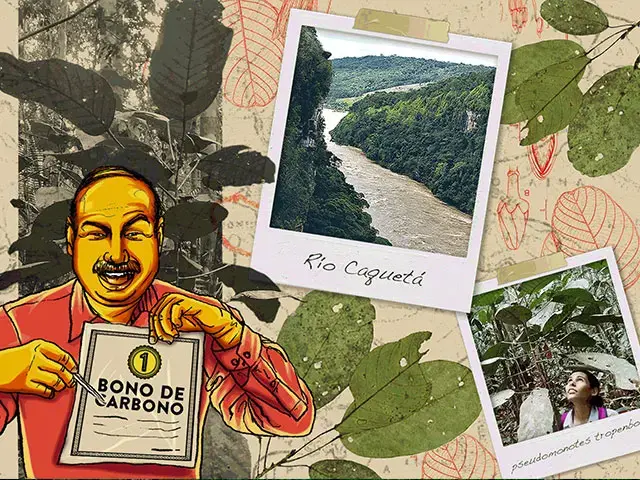
Oxigreen, one of the many companies traveling the Colombian Amazon promoting carbon projects with Indigenous communities, is starting one with the Nonuya de Villazul reservation in the mid Caquetá River. The project is managed by a politician sanctioned for mismanagement in Casanare and banned from holding public office and contracting with the State.
Note: You can read this investigation in Spanish in La Silla Vacía and Mongabay.
Sporting a black moustache and overalls, an animated figure dashes across the screen, looking like the Super Mario of the 1980s video games played around the world.
He jumps over obstacles and dodges bullets to the rhythm of synthesizer music, while claiming a corn on the cob, a fish, and a wad of bills give him the strength to continue. After passing a forest of lanky palm trees, he reaches a river that seems to slow him down, but he pulls out a hammer and, after quickly building a bridge, crosses to the other side. With his tool still in his hand, he leaves behind brand new public works in several towns: a hospital in Santa Rosalía, a school in Cumaribo, a road in La Primavera and, finally, a coliseum in Puerto Carreño.
It's not Mario, though, nor his devoted brother Luigi: It’s Super Henry, a politician who with this original animation tried to sway the voters of Vichada in 2015 to elect him governor.

Whistleblowers and others in possession of sensitive information of public concern can now securely and confidentially share tips, documents, and data with the Pulitzer Center’s Rainforest Investigations Network (RIN), its editors, and journalists.
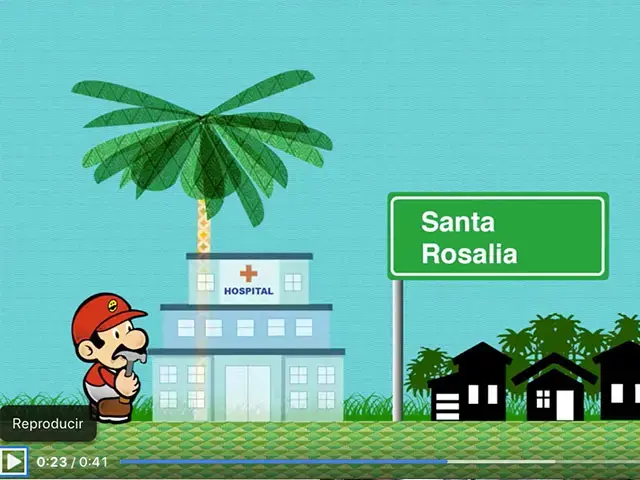
This was the second time Henry Silva Meche aspired to be governor of this vast and scarcely populated Colombian department in the far east of the country, a territory of grasslands that extend beyond the Orinoco River into Venezuela. It is a region disconnected from urban centers, and whose 107,000 inhabitants are among the poorest in the country.
In the end, as a Liberal Party candidate, Silva obtained 6415 votes and could not emulate the victorious leap to the flag of his virtual alter ego Super Mario.
Seven years later, ‘Super’ Henry is still touring Colombia’s lush geography, no longer in search of votes, but of carbon projects with which communities fighting deforestation can sell carbon credits to companies seeking to offset their environmental footprint. As general manager and legal representative of Oxigreen S.A.S., he has visited the area of the mid Caquetá River in the Colombian Amazon, in the vicinity of Chiribiquete Range National Park, to persuade several Indigenous reservations to embark on joint projects in the carbon market. He has already managed to sign an agreement with at least one reservation, Nonuya de Villazul.
However, between his failed campaign for governor and his reinvention as a carbon credit entrepreneur, Henry Silva received some bad news: In May 2018, the Comptroller General’s Office found him responsible for the loss of public funds. The agency that oversees the proper use of public resources of Colombians accused and sanctioned him for improperly overseeing a contract while working for the Governor’s Office of Casanare, as well as for allowing the contract to be liquidated and paid even though the contractor never fulfilled his duties.
The ruling brought him two disciplinary consequences: In August 2018, the Inspector General’s Office registered a five-year ban from public office and an equivalent suspension from contracting with the State. Both are effective until August 1st, 2023. Silva Meche acknowledges the sanction’s existence, but says he’s awaiting a final appeal to annul it and argues that it only restricts his working relationship with the public sector, but not with Indigenous communities or other private actors.
This means that several Indigenous communities in the Colombian Amazon are discussing -or have already decided- entering into projects of payment for ecosystem services with a former public official disqualified for mismanagement. Moreover, as far as this investigation by the Latin American Center for Investigative Journalism (CLIP), Mongabay Latam and La Silla Vacía, with the support from the Pulitzer Center’s Rainforest Investigations Network and additional reporting by the Organized Crime and Corruption Reporting Project (OCCRP), was able to confirm, Silva did not inform his would-be partners of this sanction. Two Indigenous leaders from the Nonuya de Villazul reservation told this journalistic alliance that Silva Meche never told them anything.
This piece is part of ‘Gray Carbon’, a journalistic series seeking to make the carbon market in Latin America more transparent.
Pesos for keeping the forest
Oxigreen S.A.S. is one of the newest players in Colombia’s rapidly growing voluntary carbon market.
Over the past five years, nearly a hundred private carbon projects -called Redd+- have sprung up across the country. They seek to link local communities that care for strategic forests that mitigate the global climate crisis with companies willing to buy carbon credits to offset their own use of fossil fuels. One credit is equivalent to one ton of carbon dioxide -one of the greenhouse gases that cause climate change- which as a result of these conservation efforts would no longer be released into the atmosphere.
Such schemes were incorporated into the United Nations Convention on Climate Change to connect national governments that are curbing deforestation with others that want to pay for those results. Colombia decided to expand them to include private projects from the voluntary carbon market. Redd+ projects have since expanded into the country’s Amazon and Pacific rainforests, but also into the Caribbean mangroves, the Andean high-altitude moors, and the grasslands of the Orinoquia, where Henry Silva hails from.
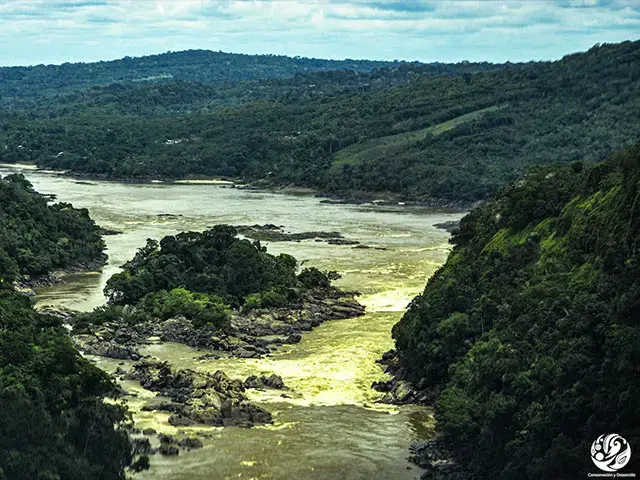
There are three reasons for this boom. The first is that the Colombian government created a tax incentive in 2017 that allows companies using fossil fuels to reduce or avoid paying the national carbon tax by buying carbon credits. The second is that a large part of Colombia’s jungles and forests -totaling 600,000 square kilometers, or the area of Ukraine- is guarded by Afro-descendant and Indigenous communities that usually have collective ownership and effective governance of their territories, which is why many companies began to seek them out to promote private carbon projects. The third factor is the possibility of turning a high profit, with scarce technical, social or environmental oversight of projects by the state.
These factors explain the rapid proliferation of these projects, which often overlap and compete with another pioneering Redd+ state-led initiative called Vision Amazonia, whereby Norway, Germany, and Great Britain pay Colombia an annual sum based on results in the fight against deforestation. This income is then distributed among Indigenous and farmer communities, and government entities in the environmental sector. The boom has been such that by September last year, the Ministry of Environment’s platform had almost 90 private Redd+ initiatives registered in different stages of progress or implementation, before the page was no longer accessible due to maintenance.
Oxigreen is now competing in this market.
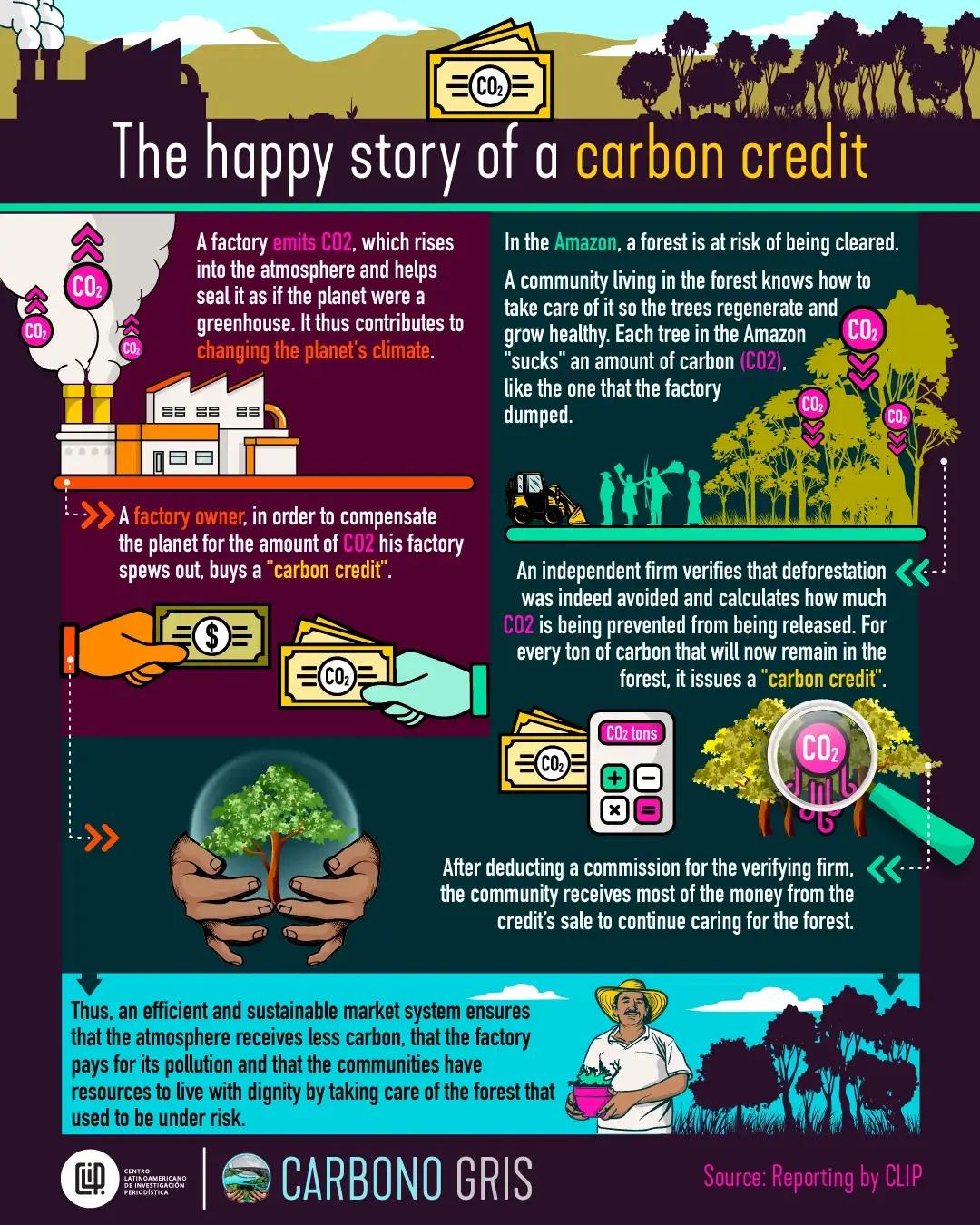
Oxigreen’s debut
Oxigreen S.A.S. was created on July 12th, 2021 in Bogota, with the aim of promoting the “formulation, promotion and execution of Redd+ programs or projects and others that are viable for the social, environmental, economic, scientific, administrative and cultural development of Indigenous, Afro and other communities,” according to its incorporation document.
Its three founding partners did not seem to be thinking of dealing exclusively in the carbon market because they also registered numerous complementary activities, such as the installation of nanotechnology water filtration systems, the cultivation of African oil palm, the extraction of stone, or the trade of liquor and cigarettes.
Three partners head Oxigreen: Juan Eduardo García Trejos with 25% of the shares, María Paula Alonso Gamboa with 38%, and Henry Alejandro Silva Pérez, with 37%.
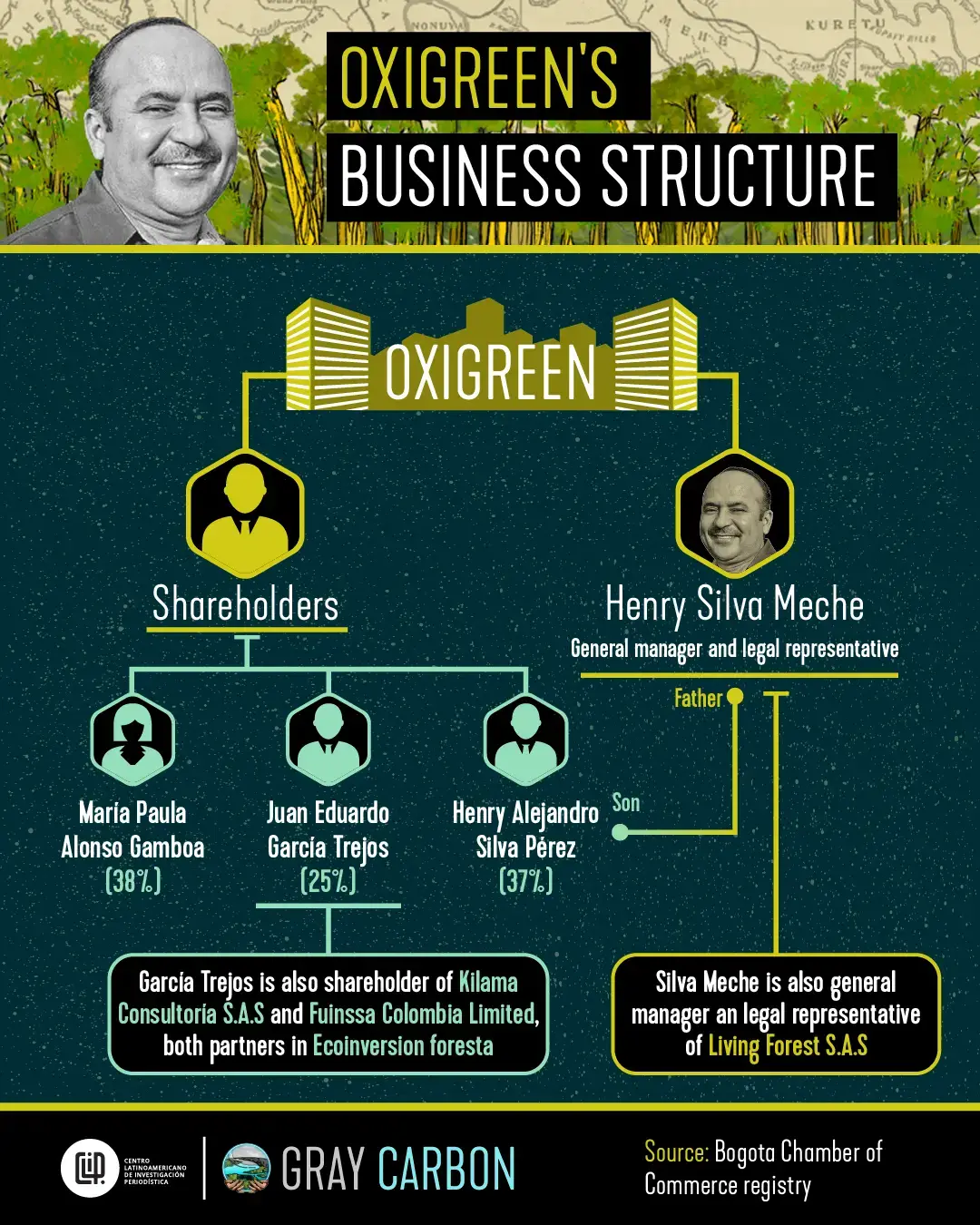
The most publicly recognizable figure is García Trejos, a native of Cumaribo, who ran for representative in the departmental assembly of Vichada in 2015, in the same elections that Silva Meche ran for governor. According to public records, García is also the legal representative and shareholder of two other environmental companies: Kilama Consultoría S.A.S., which was also registered in 2021 to develop Redd+ projects, and Fuinssa Colombia Limited, which is the Colombian subsidiary of a British company of the same name. Fuinssa was created to market the services of an environmentally-minded fintech called Quayambaya Fintech Ecosystem & BNHE Concept. These two companies are partners in another environmental company, Ecoinversión Forestal, which seeks to increase industrial reforestation.
In turn, Henry Alejandro Silva Pérez, a geologist recently graduated from the National University who has worked at the Colombian Geological Service, is Henry Silva Meche’s son.
These shareholders elected Silva Meche general manager and legal representative of the company from the day from its creation in mid-2021.
From politician to carbon entrepreneur
The visible head of Oxigreen is the same 'super' Henry Silva Meche, a petroleum engineer, who has made a career as a politician and public official in Vichada and the neighboring department of Casanare.
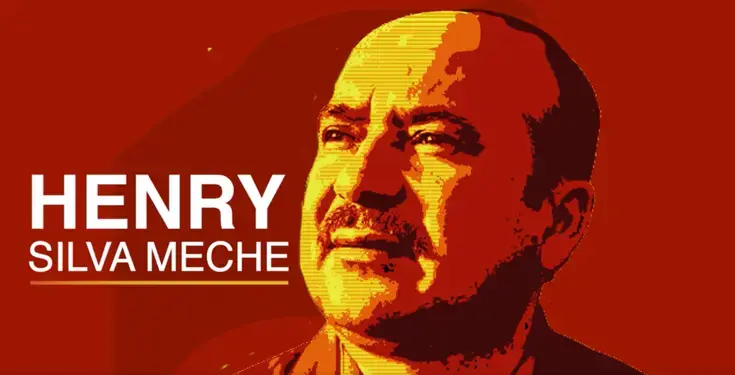
A native of the oil-producing town of Paz de Ariporo, he held his first relevant public position two decades ago when he was manager of the now defunct La Nueve Millonaria Lottery, which belonged to nine departmental governments. Between late 2009 and mid-2011, he was private secretary to Casanare Governor Raúl Flórez. In 2011, he ran for the governorship of Vichada for the first time, but only came in third. The following year, he was a candidate for director of Corporinoquia, the environmental authority for the entire eastern region of the country. In 2015, he ran again for governor -acting as super Mario and recording commercials in the Sikuani Indigenous language- and came in second. In 2016, he was general and government secretary of the mayor’s office of Cumaribo, in Vichada.
Silva Meche comes from a family with a long political tradition. His brother Jorge Julián was a congressman for Vichada for more than a decade, and another brother, Bernabé, was governor of the Amazonian department of Vaupés.
Silva Meche’s political rise was cut short when, in May 2018, the Comptroller General’s Office found him responsible of mismanagement in the case of a contract he had overseen a decade earlier during his time as private secretary to the governor of Casanare.
Following a five-year investigation, the Comptroller determined that a contract signed by the Governor’s Office of Casanare in June 2009 with a company called Corporación Gerencia de Proyectos (GP) to identify the beneficiaries for a housing project, totaling 1806 million pesos (625 thousand dollars at the time), was not executed appropriately.
According to the Comptroller’s Office, the company was originally contracted to identify families that would be the possible beneficiaries of 2445 new social housing units and 2933 home improvements in 19 municipalities in this department on the eastern plains. At the end of the contract, GP Corporación was to deliver this list of 5208 potential “housing solutions” to the governor’s office so that it could, in turn, structure a subsidized housing project. To do so, the company had to identify the potential beneficiaries, review their documentation, visit the rural properties where the houses would be built, and draw up the blueprints for the houses set to be improved.
The problem, according to the Special Anti-Corruption Investigations Unit of the agency in charge of overseeing public funds, is that the contract’s goals were never met. This was partly because, in March 2010, one month after the contract had been extended, the company and departmental government officials modified the goals: They increased the number of new housing solutions to 3405 and decreased the number of home improvements to 1983. But above all because the contractor did not end up meeting them: GP Corporation delivered -according to the Comptroller- 1625 of the former and 1336 of the latter.
Despite the contractor’s failure, the government officials signed receipt of the products, settled the contract, and paid the missing amount. “It is not understood how a termination act is drawn up, much less a liquidation act of a contract without establishing that the purpose for which the State’s money had been destined was fulfilled,” the Comptroller’s Office wrote in its indictment.
Non-compliance meant damages to public assets valued by the Comptroller’s Office at 705 million pesos, which -adjusted to 2018 prices- amounted to 926 million pesos (320,000 dollars then). Additional to this was the impact resulting from the fact that, according to the state agency, “1780 families were unable to obtain the housing benefit and 647 families also didn’t get a home improvement.”
The Comptroller’s Office argued that Henry Silva Meche was one of the public officials responsible for the supervision and oversight of the contract given that, in December 2009, his boss Governor Raúl Flórez, had delegated to him by decree the management of all the department’s spending, including the power to open tenders, award contracts or impose fines. “By omitting to exercise his duty of direction, monitoring and control of the execution (...) he allowed the contractor to carry out greater amounts of activities per item and, consequently, to defund other activities of other items necessary to comply with the object of the contract. Omissions that were determinant in the generation of the damage,” said the Comptroller’s Office, describing his behavior as “gross negligence.” As a result, it ruled against him for fiscal responsibility.
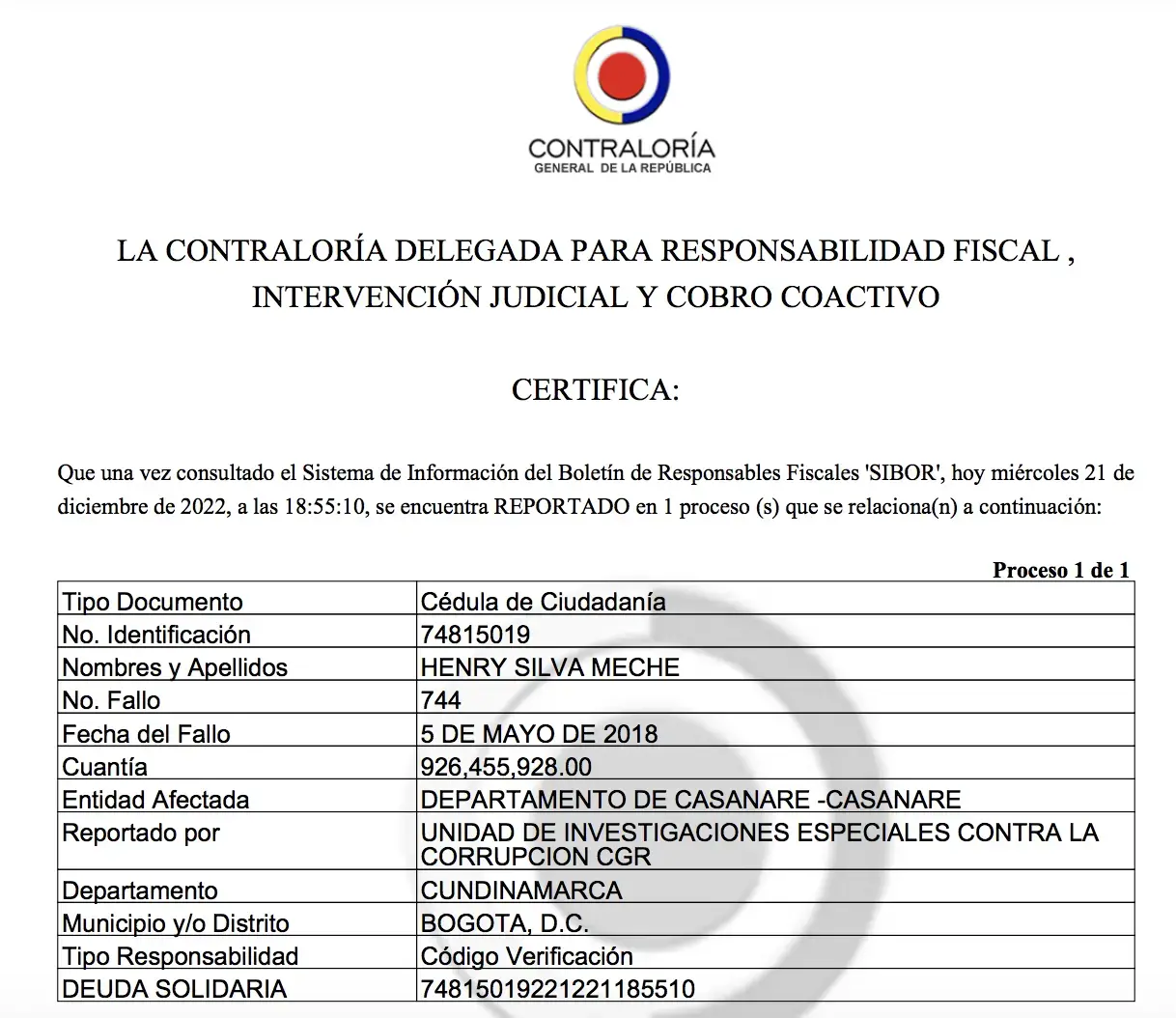
The Comptroller’s Office also blamed two other public officials of the governor’s office, including the director of planning and the housing advisor who had been the direct supervisors of the agreement, as well as the contractor. According to the agency, they, as well as Silva Meche, “omitted their duties by determining that the object (...) had been executed in its entirety, without the respective observations being made and without requiring the company Gerencia de Proyectos - GP Corporación to comply with the entire object agreed upon”.
Silva Meche appealed the ruling arguing that his conduct had not contributed to the fiscal loss, since -he said- he’d never been delegated the power to determine expenditure or to monitor contracts and that, moreover, he had not ordered any transfer of funds to GP Corporación. On August 3rd, 2018, the then Comptroller General Edgardo Maya dismissed his appeal –saying “he had the obligation of surveillance and control regarding the execution of the contract”- and let the decision stand.
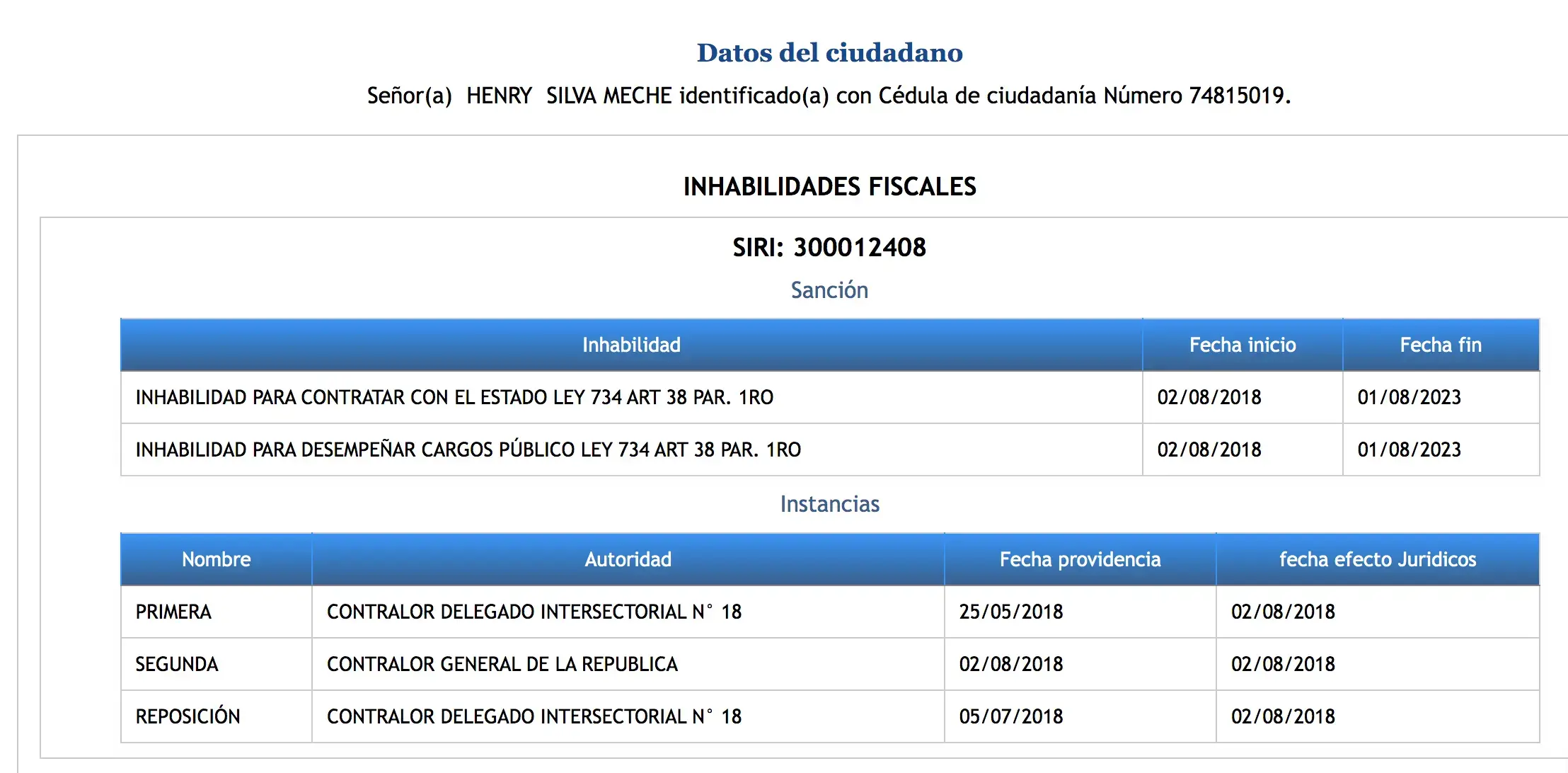
That same week, the Inspector General’s Office registered in its system that the decision generated two of the harshest existing disciplinary sanctions in Colombia: barring him from public service and from contracting with the State.
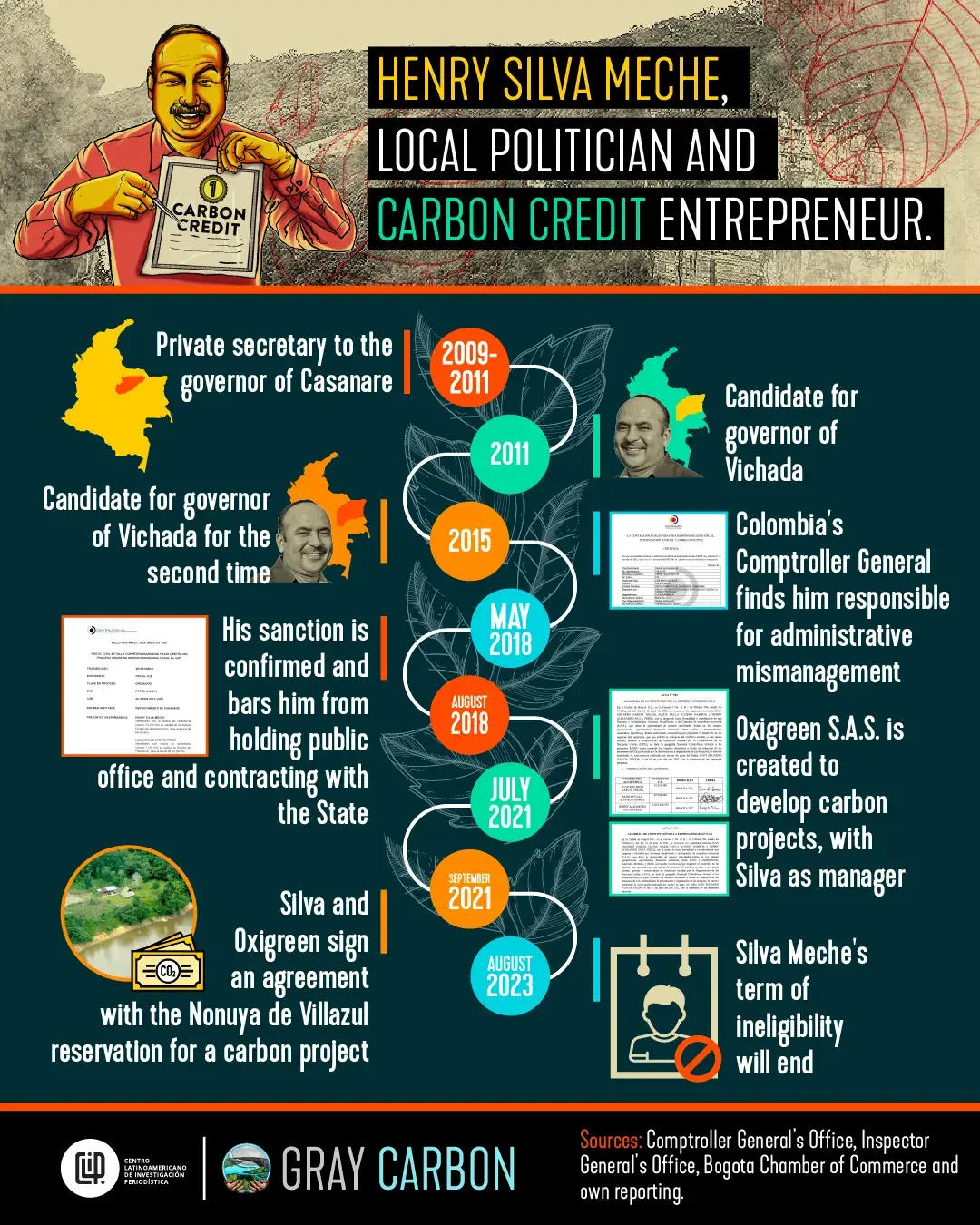
Carbon in the middle of the Caquetá River
Three years after his sanction and with two more years to go in his disbarments, Henry Silva Meche has spoken to at least two Indigenous communities in the Amazon to propose joint carbon projects.
Oxigreen representatives proposed a carbon project to leaders of at least one Indigenous territory on the banks of the middle section of Caquetá River, the Monochoa reservation, but in the end the Indigenous community there chose to partner with another company called Yauto S.A.S., one Indigenous leader told this journalistic alliance.
Oxigreen had better luck with another reservation in the same area, Nonuya de Villazul, whose leaders signed an agreement with Silva Meche in September 2021 to structure a ten-year Redd+ project, which can be extended twice up to a total term of 30 years.
The document –which this journalistic alliance had access to- stipulates that the project shall be certified with the Verified Carbon Standard (VCS) of the U.S. organization Verra and that its profits will be distributed 70% to the communities and 30% to the company. Although the project does not yet appear in Renare, the national government’s platform for mitigation initiatives, Oxigreen’s manager and the Indigenous leader heading the project confirmed to this journalistic alliance that it is in the process of formulation and that they expect to present it for certification in the coming months. According to two Indigenous leaders, Henry Silva Meche was there at least twice during the conversations.
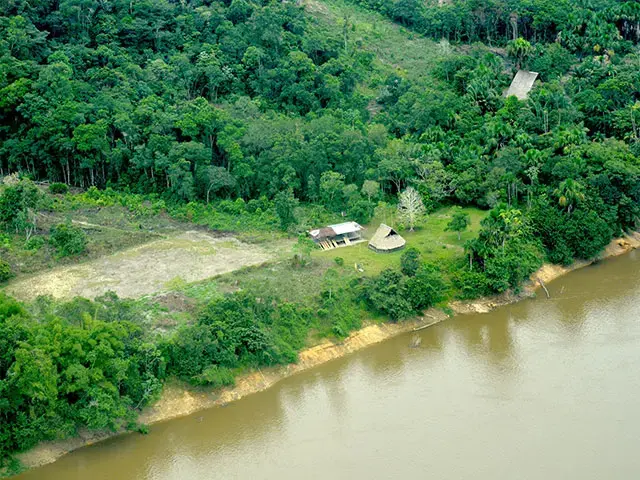
According to two Indigenous leaders, the person in charge of the project design document (or PDD) that sustains it technically is William Laguado Cervantes, a forestry engineer who has led the Carbono & Bosques Research Center for over a decade. This non-profit consulting firm from Antioquia has participated in the setup of other Redd+ projects in the country, such as the one led by Corpochivor in Boyacá with the support of the Swiss company South Pole, or the Allcot group one in the vicinity of La Macarena Range National Park, in southern Meta. In addition to structuring the Nonuya project, Laguado has a business relationship with one of Oxigreen’s partners: he is a shareholder and cofounder of Kilama Consultoría S.A.S. together with Juan Eduardo García Trejos, according to its chamber of commerce documents.
In a response to this journalistic alliance, Silva Meche said that Oxigreen is finishing the project design document and that, in his words, “the company is seriously analyzing taking the path of an international standard, which could well be VCS-Verra”. He explained that getting the Nonuya de Villazul project underway is Oxigreen's “short-term priority” and that it “will be submitted to a standard, either national or international, in about two or three months”.
Asked about the status of the project, U.S.-based organization Verra responded that to date it has not received any applications matching the description and that there are still no Oxigreen-linked files in its registry.
Nonuya de Villazul is a reservation of almost 2,600 square kilometers on the banks of the Caquetá River in the department of Amazonas, an area that -despite the proximity of damaging activities such as illegal gold dredging- is still relatively well preserved. Sandwiched between two of the country’s largest Indigenous reservations, this clover-shaped territory was created in 1988 as part of then President Virgilio Barco’s pioneering policy of creating collective Indigenous territories, whereby 200,000 square kilometers of Amazon rainforest came under this form of governance. Two decades later it was expanded, quadrupling it to its current size. Today, it is home to some 270 people in its two communities of Villazul and Peña Roja, mainly from the Nonuya and Muinane peoples.
Despite being smaller than several of its neighboring territories, Nonuya has occupied a unique place in the history of scientific study of the mid Caquetá River area, which tropical biologist Carlos Rodríguez doesn’t hesitate to describe as “the most and best studied in the Amazon” because of the hundred or so investigations carried out there between the mid-1980s and the beginning of this century.
The reservation’s jungle -the size of Luxembourg- has been the site of significant discoveries. In 1995, three Colombian botanists found a unique tree new to science, which they named Pseudomonotes tropenbosii. Given that it was classified in a family which until then only had species in Asia and Africa, its discovery gave weight to the hypothesis that the oval-leaved, winged-seeded giant could date back to when the protruding corner of South America still fit inside the Gulf of Guinea.
That discovery was so striking that it warranted a mention in the journal Science and was described by the New York Botanical Garden as “the botanical equivalent of finding a gorilla population living in the Colombian jungle.” “If we’re finding forest trees 250 feet [75 meters] high, shouldn’t we get going and find out what’s there before we cut it all down in the next 30 or 40 years?” said respected U.S. botanist Peter Raven at the time.
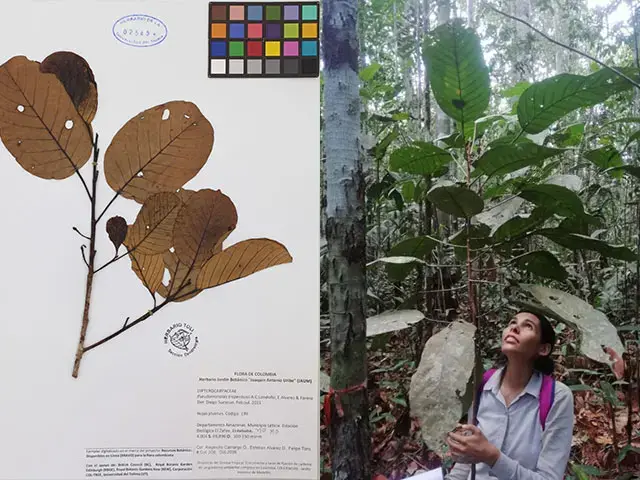
“Although they had no use for it, neither as timber nor as food, it was a tree known to the Indigenous people, especially because its seed is very characteristic and visible. They laughed when people said it was a new species, almost saying ‘but we’ve known it since we were kids,’” recalls Carlos Rodríguez, who still directs the Tropenbos Colombia foundation, which worked for years in the area and in whose honor the tree was named.
In addition, the reservation is home to what is perhaps the oldest plot for long-term ecological forest studies in Colombia and one of the oldest in the entire Amazon, where biologists and botanists have been conducting forest inventories and doctoral research continuously since the late 1980s.
There is another fact that attests to the social and cultural value of Nonuya: One of the most singular Colombian artists of the last decades emerged from its borders, although he no longer lives there.
Abel Rodríguez Muinane, an 81-year-old Nonuya elder commonly known as ‘the plant namer’ has become famous for his exquisite large-format drawings of the Amazon rainforest. With delicate brushstrokes of ink and watercolor on paper, he captures the intricate layering of the rainforest in his works: its shrubs and tapirs on the ground, bromeliads and lianas hanging from the trunks of the undergrowth, parrots and monkeys eating fruits in the canopy.
The pictorial technique of ‘don Abel’ -as he’s often called- has greatly impressed the botanists he used to guide three decades ago in his jungle expeditions, partly because of his depictions of more than 300 plant species clearly distinguishable from each other, but also because he captures with photographic precision even the shapes of the treetops -something very difficult to appreciate from the ground- and because he always paints from memory. In addition to their aesthetic appeal, his drawings incorporate the uses given to each plant, their relationships with animals and even the physical changes observable according to the season. All this underscores how, in addition to being an accomplished artist, Rodriguez has a profound knowledge of Amazonian ecosystems and their plants, which he inherited from the elders of his community, and which has fostered an enriching ‘dialogue of knowledge’ - in Carlos Rodriguez’s words - with the scientific community.
This mixture of ancestral wisdom and plastic exuberance has earned Abel enormous respect, to the point that his work has reached artistic spaces such as the Kassel Documenta or the Museum of Modern Art in New York, and earned him the Dutch government’s Prince Claus Award. In Colombia, one of his drawings is on permanent display at the National Museum in Bogota and, as a descendant of Indigenous people who fled the abuses of rubber tappers in the early 20th century, he was invited to the series of conversations on art and armed conflict held by the Truth and Reconciliation Commission stemming from the 2016 peace agreement.
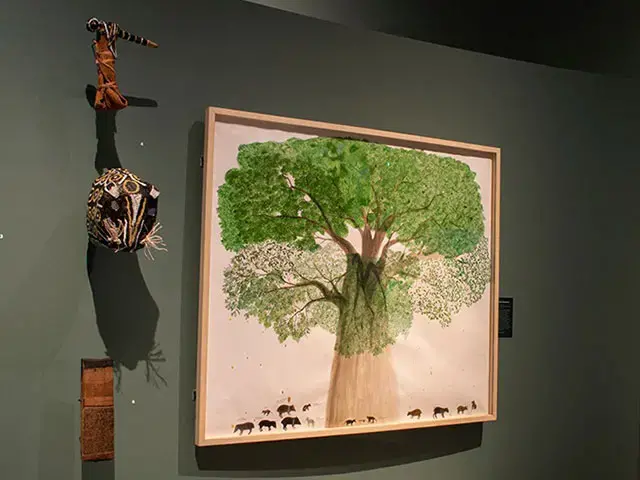
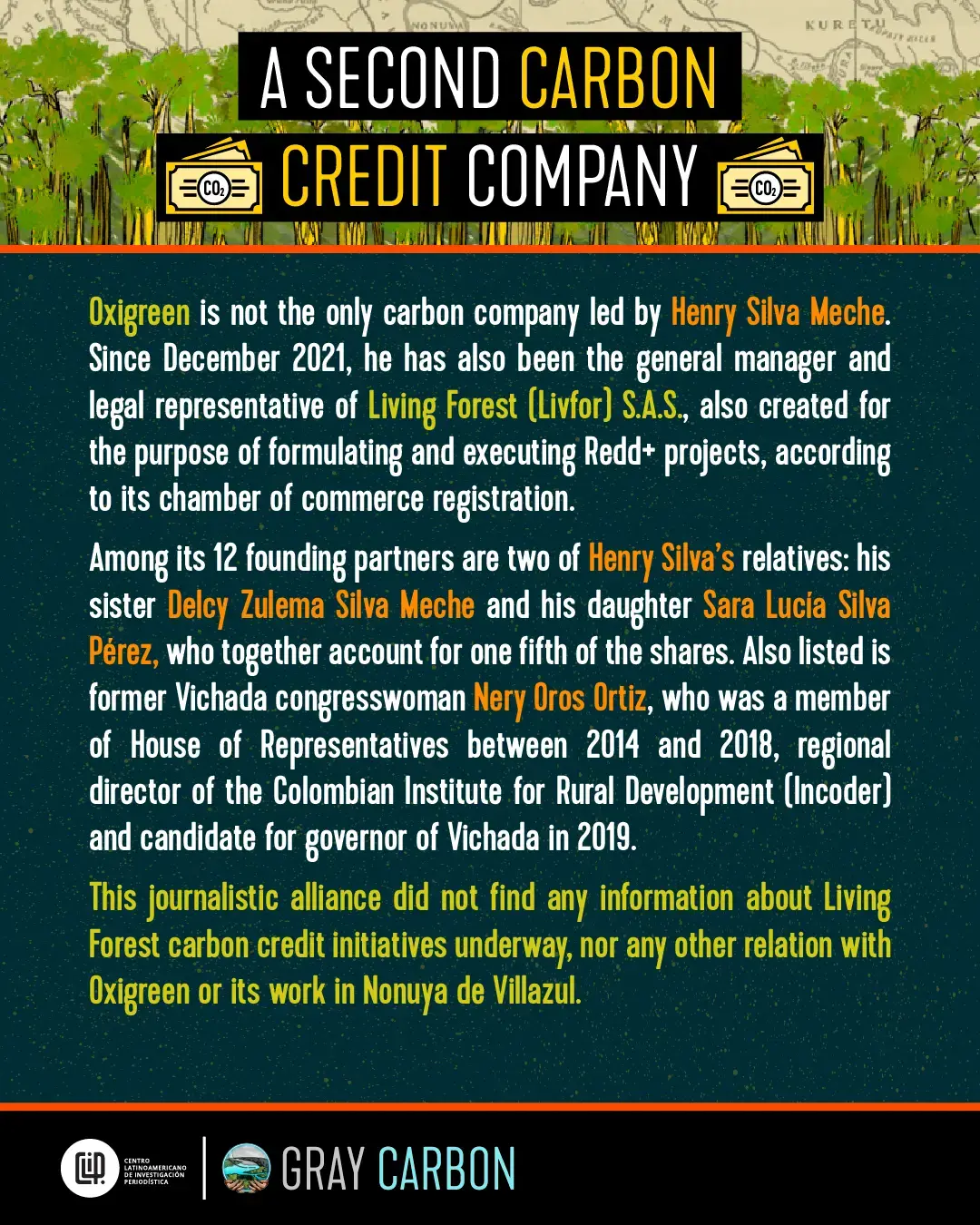
Unknown background in Nonuya
The fact that the project developer has been sanctioned in the past for mismanagement by the two main Colombian anti-corruption agencies and is currently banned from handling public funds has raised concern among several indigenous leaders of Nonuya about their project’s future.
Although the government of former President Iván Duque considered carbon projects to be deals between private parties, their sales have an impact on the treasury. Many of the credits traded in the domestic market are being used by their buyers, usually companies such as airlines or gasoline distributors, to offset their fossil fuel use and thus avoid paying the carbon tax. In other words, even though the projects are developed with private resources, their results are used to reduce the carbon tax largely destined to fund the environmental sector.
When asked if they knew about Silva Meche’s current disbarments, two Indigenous leaders of Nonuya de Villazul told this journalistic alliance that they had heard rumors, but that the subject had never come up in conversations with the company or its manager.
“He never told us anything about it. So one thinks, how transparent have they been?” says one leader, who asked to withhold his name to avoid deepening divisions in the territory and given the security risks in the area, where several rebel structures that did not join the 2016 peace deal with the former FARC or subsequently took arms up again still roam.
For this leader, the first alarm about Oxigreen arose when he learned from an acquaintance that the company doesn’t have a website and that there is no further information about it on the Internet. His concern increased when that same person told him that she had found information about Silva Meche’s fiscal sanction. These two elements, plus what he describes as the company’s repeated lack of response to calls from Indigenous leaders and the absence of information on the project’s progress, have increased dissatisfaction in Nonuya. “That’s what doesn’t seem right to me. If we are partners, how come we don’t keep each other informed? It’s not very transparent,” he says. Given that another group of people in the reservation still defend the company, he interprets it as the first signs of an internal rift over carbon credits.
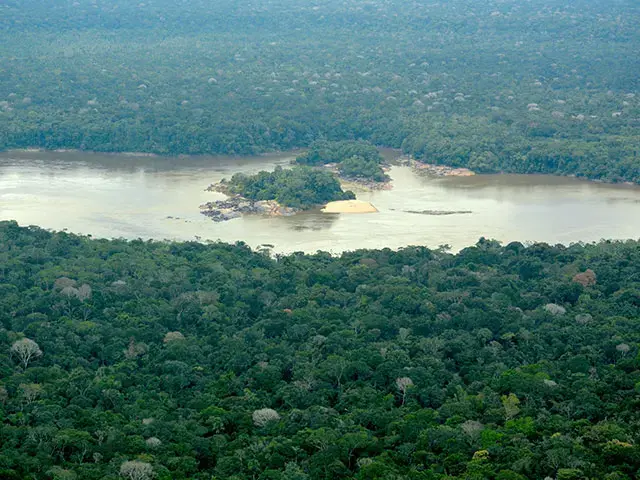
“I couldn’t say I knew. There were comments saying so, but my hands have never held a document stating it and he hasn’t told us,” says another leader, underscoring that the most important thing is that any economic solution respects the ways of life of local communities and their conservation practices. “I think it’s important that there is clarification of these things for the wellbeing of our process,” he added.
Edwin Paky, the Muinane leader who has promoted the project, told this journalistic alliance that they signed an agreement with Oxigreen because, after listening to them in a community assembly, they found their proposal more convincing than the one presented by Yauto. He acknowledges that there have been difficulties in the past year because, in his view, communities are expecting the rapid arrival of funds to the territory, but he assures that the project’s formulation is well underway and is convinced it could be validated and certified by mid-2023. This means that they could be selling their first credits a few months later, with resources that, according to Paky, would allow them to solve problems such as the poor state of the Peña Roja school, the lack of gasoline for the school transport boat, or the fact that the health post is equipped but has no doctor.
For Paky, one of the advantages of Nonuya de Villazul in the carbon market is that the reservation has a robust repository of data that they have collected in the two forest monitoring plots they established. A 6-hectare plot dates to 2010 and includes the 1.2-hectare plot created with Tropenbos Colombia three decades earlier. The other, of one hectare, was set up in 2014 with support from the Sinchi Institute, the government’s Amazon research center. “We advanced faster because of the data we already had, the product of 10 years of carbon monitoring,” says Paky, who is an agroecological engineer and worked for several years in Sinchi’s Amazon herbarium. His own undergraduate thesis at the Universidad de la Amazonia, published in an academic journal, measured carbon in the largest plot. According to Paky, William Laguado and Oxigreen have incorporated that data into the formulation of the Redd+ project.
Regarding the fiscal sanction against Oxigreen’s manager, Edwin Paky says that they were indeed informed. Although he is not familiar with the details and hasn’t seen the documents from the Comptroller’s Office that support them, he says that Silva Meche addressed the issue before signing the agreement with Nonuya, in response to a question from the community. “He said that he had worked in the governor’s office and that there are things that one does not do but whose price one pays, but that this had nothing to do with Oxigreen,” he explained, adding that Silva Meche emphasized that the company had no legal problems and that he offered to withdraw from management if there were inconveniences. Asked if he believes that the manager’s background could affect the project, the Indigenous leader pointed out that “at the time it did not worry us, but we did not pay much attention to it and we focused on structuring the project,” but that, “when the funds arrive, we’ll need to oversee a correct financial management.”
“I have no legal or moral inability to hold one or two positions in the private sector, either nationally or internationally,” Henry Silva Meche told this journalistic alliance. In a written response, he acknowledged the Comptroller General's sanction, but emphasized that this has no relation whatsoever with his work as head of Oxigreen and that these are facts of public knowledge.
“Yes, I was sanctioned in an irregular and grotesque manner by the Comptroller's Office (...) without being responsible and without my administrative and delegated functions having the scope of authorizing expenditure or being competent to follow up on the administrative case for which I was declared fiscally responsible,” he told this alliance, explaining that he filed an appeal for annulment before the Administrative Court of Cundinamarca and that he delivered his final plea last October. “I’m waiting for the ruling of this court, after almost five years of struggle in defending my good name,” he said, underscoring that "I was declared fiscally responsible jointly with others, not for acts of corruption." (Silva Meche's full response can be read here).
Silva Meche argues that the sanction and disbarment do not affect his ability to manage a carbon project, as they only restrict his professional relationship with the three branches of State. Since Indigenous reserves are not public entities and their territory is considered private property, he explained, “there is no inability for me to sign alliances, agreements or any type of contract, since this would be done in the private sphere and not in the public one.” Likewise, he insisted that as manager and legal representative of Oxigreen he has not received “any administrative sanction or of any other nature.” He did not answer if he informed the Indigenous leaders of Nonuya de Villazul about his sanction and, if so, to whom and when.
Although the project that would allow Nonuya de Villazul to issue carbon credits for protecting the Amazon rainforest has not yet seen life, everything indicates that it will be backed by a businessman and former politician whose integrity has been questioned by one of the main anti-corruption agencies in Colombia.
Infographics: Miguel Méndez
Legal review: El Veinte
Gray Carbon is a project led by the Latin American Center for Investigative Journalism (CLIP) on the carbon market in Latin America, in partnership with Mongabay Latam, La Silla Vacía, Rutas del Conflicto and La Liga contra el Silencio, with support from the Pulitzer Center's Rainforest Investigations Network. Additional reporting was provided by Lara Dihmis and Organized Crime and Corruption Reporting Project (OCCRP).









